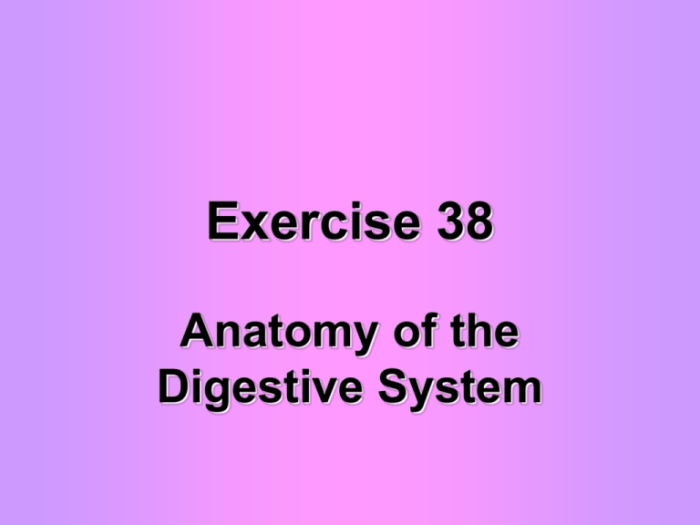Exercise 38 anatomy of the digestive system – Embark on a journey into Exercise 38: Anatomy of the Digestive System, an exploration that unravels the intricacies of the body’s digestive apparatus. This comprehensive guide delves into the structure, function, and clinical significance of the organs responsible for nutrient absorption and waste elimination, providing a thorough understanding of this vital physiological system.
Throughout this discourse, we will traverse the digestive tract, examining the esophagus, stomach, small intestine, large intestine, and accessory organs such as the liver, pancreas, and gallbladder. By scrutinizing their histological features, blood supply, and innervation, we gain a profound appreciation for the harmonious functioning of the digestive system.
Overview of the Digestive System: Exercise 38 Anatomy Of The Digestive System

The digestive system is responsible for the breakdown of food into nutrients that can be absorbed and utilized by the body. The major organs involved in digestion are the mouth, esophagus, stomach, small intestine, large intestine, liver, pancreas, and gallbladder.
The digestive tract, which is the path food takes through the body, begins at the mouth and ends at the anus.
Functions of the Digestive System, Exercise 38 anatomy of the digestive system
- Ingestion: Taking in food through the mouth.
- Mechanical digestion: Breaking down food into smaller pieces through chewing and muscular contractions.
- Chemical digestion: Breaking down food into its chemical components through enzymes.
- Absorption: The passage of nutrients from the digestive tract into the bloodstream.
- Elimination: The removal of waste products from the body through defecation.
Major Organs Involved in Digestion
- Mouth: The entry point of food into the digestive system.
- Esophagus: A muscular tube that transports food from the mouth to the stomach.
- Stomach: A J-shaped organ that stores and partially digests food.
- Small intestine: A long, coiled tube where most digestion and nutrient absorption occur.
- Large intestine: A wider tube that absorbs water and electrolytes and stores waste.
- Liver: A large organ that produces bile, which aids in fat digestion.
- Pancreas: A gland that produces enzymes and hormones that aid in digestion.
- Gallbladder: A small sac that stores bile produced by the liver.
Anatomy of the Esophagus

The esophagus is a muscular tube that connects the mouth to the stomach. It is approximately 25 cm long and located in the mediastinum, the space between the lungs.
Structure and Location of the Esophagus
The esophagus has three layers: an outer layer of connective tissue, a middle layer of smooth muscle, and an inner layer of mucous membrane. The smooth muscle layer allows for the peristaltic contractions that propel food down the esophagus.
Layers of the Esophageal Wall
- Adventitia: The outermost layer of connective tissue that anchors the esophagus to surrounding structures.
- Muscularis externa: The middle layer of smooth muscle that propels food down the esophagus through peristalsis.
- Mucosa: The innermost layer of mucous membrane that lines the esophagus and secretes mucus to lubricate the passage of food.
Function of the Esophageal Sphincters
The esophagus has two sphincters, the upper esophageal sphincter (UES) and the lower esophageal sphincter (LES). The UES prevents air from entering the esophagus during respiration, while the LES prevents stomach contents from refluxing back into the esophagus.
Anatomy of the Stomach

The stomach is a J-shaped organ located in the left upper quadrant of the abdominal cavity. It is responsible for the storage and partial digestion of food.
Shape, Size, and Location of the Stomach
The stomach is approximately 15 cm long and has a capacity of about 1 liter. It is divided into four regions: the cardia, fundus, body, and pylorus.
Functions of the Stomach in Digestion
- Storage: The stomach stores food for several hours, allowing for gradual digestion.
- Mechanical digestion: The stomach churns and mixes food with gastric juices, breaking it down into smaller particles.
- Chemical digestion: The stomach secretes gastric juices containing hydrochloric acid and enzymes that begin the chemical breakdown of food.
Different Regions of the Stomach
- Cardia: The region where the esophagus enters the stomach.
- Fundus: The dome-shaped upper region of the stomach that stores food.
- Body: The main central region of the stomach where most digestion occurs.
- Pylorus: The lower region of the stomach that leads to the small intestine.
FAQ Overview
What is the function of the esophagus?
The esophagus is a muscular tube that transports food from the mouth to the stomach. It does this through a series of involuntary muscle contractions known as peristalsis.
What is the role of the stomach in digestion?
The stomach secretes gastric juices that break down food into smaller molecules. It also churns and mixes the food to further break it down.
What is the function of the small intestine?
The small intestine is responsible for the absorption of nutrients from food. It is lined with villi, which are small finger-like projections that increase the surface area for absorption.